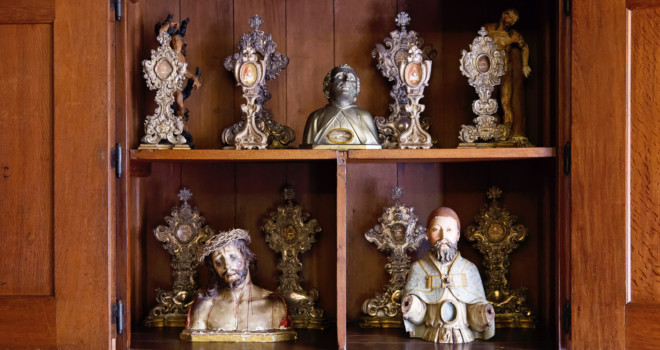For as long as I can remember, I have loved the saints.
I remember poring over children’s lives of the saints at a Catholic bookstore my parents visited. I was drawn to their stories — stories of men and women who loved and longed for God.
At the most difficult moments of life, the saints have loved and supported me through their prayers. Even in the most mundane moments, I can feel them near. (I keep St. Anthony quite busy interceding for me and my lost objects.)
But I feel closest to the saints when in the presence of
their relics.
Why We Venerate Relics
The Catholic Church’s teaching on relics is commonly
misunderstood. Why would Catholics cling to articles of clothing worn by a
saint? Why would they incase wisps of hair or slivers of bone in gold and
glass, keeping them in places of honor?
The simple, human explanation is that we want to be close to the ones we love. In my bedroom, I have a small drawer filled with reminders of the baby we lost to miscarriage — condolence cards, ultrasound images, a cloth that was draped over his casket. I treat them with great care, because they make me feel closer to him.
Many of us treasure the belongings of loved ones who have died or treat pictures of family and friends with great honor. Most families have pictures of loved ones hanging on the walls of their homes.
But the veneration of relics goes beyond that. Because the
saint is one with Christ, a member of his mystical body, the relics of saints
bring us closer to him. They are as close as we can get to him, save in the
Eucharist. We don’t worship relics, of course, but we venerate them (i.e. treat
them with great love and respect) because they are reminders of Christ. They
are glimpses of heaven.
Relics Everywhere
Every Catholic church has at least one relic, typically
incased in the altar. Some have more than one relic, and others may have an
entire collection of relics (cathedrals and basilicas commonly have this). Many
lay faithful have relics in their home. We have a first-class relic of St. Pius
X, given to my husband as thanks for his help translating something from Latin
for the diocese. I treasure it, because of St. Pius X’s love of catechesis, especially
catechesis of children.
But the most powerful way to encounter relics is visiting
the tomb of a saint.
Many tombs of saints are overseas, although a number can be found in the United States, too. One of my favorites is the tomb of St. Elizabeth Ann Seton, in Emmitsburg, Maryland. In addition to being able to kneel and pray at her tomb, you can also visit a museum dedicated to her life. I remember being deeply moved by the sight of her simple, ordinary wedding ring – a gold band like my own wedding ring, and the wedding ring of so many others.
If you want to visit as many saints’ tombs as possible, Rome
is the best place to go. The number of saints buried there is almost
overwhelming. St. Peter, St. Paul, St. Cecilia, St. Catherine of Siena, St.
John Paul II (and many, many other popes), St. Monica…the list goes on and
on.
Although these are men and women that I have known and loved for my entire life, kneeling at their tombs made me realize that they weren’t just characters in stories — they were real.
When you enter St. Peter’s, you are drawn to the main altar.
And when you reach the main altar, there is Peter, buried immediately below.
Seeing his tomb, the location of the bones of the man who was a close friend of
Christ, I was more moved than I had expected to be. Despite all that is
happening in the Church today, there was a deep reassurance in realizing that
Peter was and is, literally, the rock
on which the Church is built. This bumbling fisherman, transformed by his vocation
and an infusion of the Holy Spirit, was buried right at the heart of the Church
on earth. He was a real man, who had lived and died. He had touched Christ,
maybe shaken his hand or embraced him.
I have long been strengthened by the epistles of Paul, and
his tomb was also deeply moving. A seminarian friend of ours – whose job is to
give tours at the Basilica of St. Paul Outside the Walls – gave us a tour of
that church, culminating with reading a passage from Paul’s writings while gazing
down at his tomb. As I listened to him read, and gazed down at the tomb of St.
Paul, I was again struck with the realization that this man was a real man. He
was a real man who knew that faith in Christ was worth suffering and dying for.
This same seminarian also took us to the tombs of St. Catherine of Siena and St. Monica — also both buried in Rome — telling us that he and the other seminarians would go to ask Catherine to pray for them before exams. Likewise, he told us that all the new seminarians were taken to the tomb of Monica to pray for their own mothers. To kneel at these tombs and to realize — there are the real bones of Catherine of Siena, the real bones of St. Monica…it makes the faith feel more real than it did prior to that encounter.
When we see relics or pray at the tomb of a saint, it is
like gazing at a doorway into heaven. To encounter the real remains or belongings
of a man or woman who lived and died for Christ, points to the reality of
heaven. Heaven is worth living for and dying for. As our older brothers and
sisters in Christ, the saints point the way to the truth. They point the way to
heaven.
Relics are a source of comfort and hope — reminders that this world is not our home, and that we have been made for heaven.
✠















